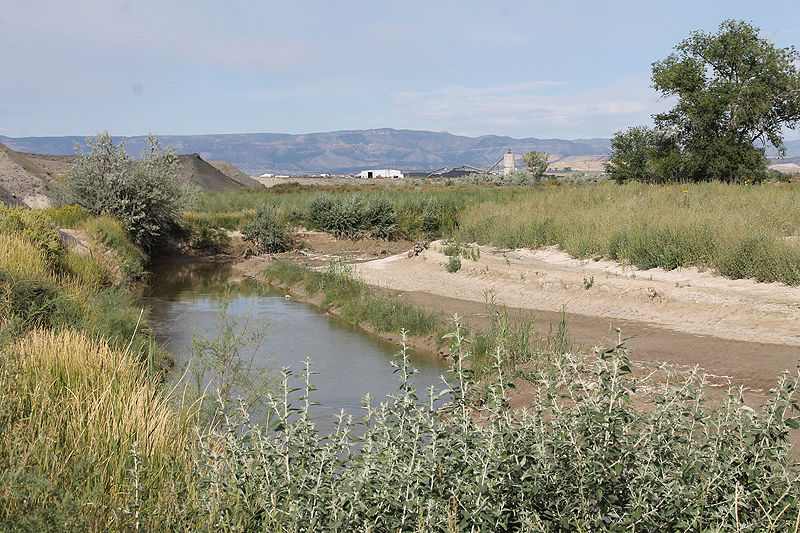Two floods in the same area of Wellington in three years have made it imperative that the Price River and its surrounding flood plain be improved so it doesn’t happen again.
“It seems it takes a long time to get things done,” said Wellington Mayor Joan Powell in an interview on Tuesday. “But it is moving along.”
The problem began a long time ago, with the river changing its course for various reasons. A buildup of debris and flora along the existing channel on the south side of Wellingtoncity compounded the problem. Around the same time the Seeley Canyon fire in the mountains of northern Emery County and western Carbon County happened. The fire aided in complicating the watershed. The huge burn scar from the fire took vegetation completely from some steep slopes. The debris from the fire, as well as a huge rainstorm last fall, left wood, rubble and vast amounts of water coming down the tributaries and into the Price River. That mess flooded places like the Pilling Trailer Court along Carbonville Road, in the county. The mess came to a virtual halt at the bridge on 100 East and at the railroad bridge in the southern part of Wellington. The water backed up stopping the upstream flow, causing it to leave the banks of the river. It flooded dozens of homes and devastated the Price River Water Improvement Districts waste water treatment plant.
Then again last fall, just as some of the residents were finally getting their homes back to normal, it happened again in spite of some work in the previous two years to get the river problems fixed.
“The first time it happened we didn’t have enough damage to warrant FEMA (Federal Emergency Management Agency) helping us,” said Powell. “The NRCS (Natural Resources Conservation Service) helped out but we only got about $30,000 after that flood. We gave that to the county and they cleaned out the area along the 100 East Bridge and did a great job. But, it wasn’t enough.”
However after the 2016 event things were different.
“When that flood happened last year the NRCS came in heavy on it,” she said. “We got approval in March to do a full fledged program to make the river better. Each state gets an allotment of money and Wellington got a good chunk of what is going to Utah this year. The overall amount awarded was about $1.3 million. With money for administration and other things the actual amount we have to work with is a little over $970,000.”
One of the things that is going to be done on the project is to build some berms. Berms along the river west of 100 East on some privately owned land, and east of 100 East. The berms will keep water from flowing into that neighborhood, if another potential flood event occurred.
The engineering firm on the project is Jones and Demille. At the August 16, Wellington City Council meeting Jared Hansen, from the firm presented some ideas about where they are at on the project. There are a number of agencies involved and individuals who own property that is important to the project.
“There are some things we needed to work out before we approached property owners,” said Hansen. “There has been some struggle trying to define what the berms are and what size they should be. Some people wanted to call them high hazard dams, channel diversion berms, etc. That could raise the cost of them and how they are constructed. It could result in some overkill in building them. We have been trying to understand, if they want class I dikes, high hazard dams or what. We think we have that ironed out now. It is important because that could be the difference between 3-4 feet high to 6-8 feet in elevation. Some people may not want the bigger ones built in their back yard.”
He said they are now ready to do the cultural site inspections to get permits, and that would begin soon (within the week). He said that because it has gone on for so long, Jones and Demille is pushing to start work at least on “opening up the ditch”. And getting some of the channel work done, similar to what has been done by the county in certain areas, very soon.
“I think that would go a long way to helping people to sleep at night,” he said.
He then asked the city’s help in getting property owners on board who are not in the areas where the berms are being considered. Consequently on Monday some of those people came into Wellington City Hall to discuss their situations and to provide comments about what they think of the plans. Powell said that the owners came in on an appointment basis and discussed their feelings with her and the engineers. Those comments and suggestions are now being considered before final plans are made.
Hansen told the council that there is enough money, in his estimation, to complete the project. He said that some of the work may be bid out in phases. He added that if there is more money needed there may be other sources of funding, including money for fuels management to work with some of the invasive species that are in the riverbed.
“If we were to apply for that kind of funding we could use that to take care of those problems and then apply the other money we have for other construction costs,” he said. “We are trying to chase all kinds of funding sources to help with this project.”
Powell said on Tuesday that if things continue to go well, work on the cleaning and armoring of the river may begin in October of this year.
River restoration project nears in Wellington

Carbon County has cleaned the river up, but the water way upstream from this point and downstream needs more work to mitigate future flooding.
